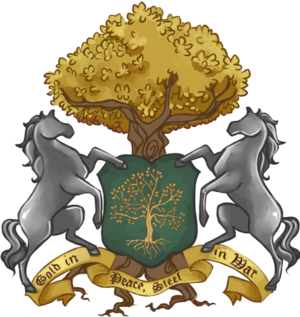Kingdom of Lotharingia
|
The Kingdom of Lotharingia, often spoken as the Kingdom of Lorraine-Savoy is an independent, predominantly human nation located around the southern part on the Island of Tahn, stretching north of the Dominion of Malin, up to the Gryphon Mountains that divide Lorraine with blackwald. The current ruler is His Majesty Odo I of House d'Amaury, King of Lotharingia, Warden of the South and Count of Metz.
History
- Pre-formation
Augustus d'Amaury (10th of the Grand Harvest, 1501 – 21st of the Grand Harvest, 1547), known as the Iron Duke in the Empire, was an Imperial noble, general and statesman. He was titled Duke of Lorraine and later Archduke of Lorraine and Kaedrin, and is the founder of House d’Amaury. He was an adviser and general in the service of the kings Olivier de Savoie and Guy de Bar and finally (And most significantly) his friend, cousin and brother-in-law, John I, Holy Orenian Emperor, serving on the latter's councils of both war and state as the acting Imperial field-marshal. Before his campaigning in the Eighteen Years' War against the dwarves, he was notorious for his controversial actions during the Dukes' War in repressing the Adrian rebels. He is considered the best general of his generation by some historians, and one of the best generals ever and is held in high regard by most former Imperials.
He is best known for his actions against the revolt of Adria in the service of Olivier de Savoie, where he repeatedly defeated the troops of Hugues Sarkozic and later rebel leaders. He is also known for the brutalities during the capture of Brelus and Barrowyk. As a reward for these military successes, he was declared ruler of the former Adrian territories, taking the title Duke of Lorraine. Though he was by birth the second son of Titus de Sola, upon his accession to the duchy he took the cadet name of d'Amaury, establishing his own, separate dynasty.
John I of Lotharingia (24th of the Grand Harvest, 1547 – 1597, formerly known as John Louis d’Amaury, was the third and posthumous son of Augustus d’Amaury. Having two older brothers, it was because of an unlikely set of circumstances that led to him becoming the Archduke of Lorraine and Kaedrin. His eldest brother Lothar was Archduke after Augustus’ death but suffered from leprosy and consequently died because of it. His second brother Jacques was Archduke for approximately a decade before abdicating leading to John Louis becoming Archduke in 1585.
- The Formation of the Kingdom
1593: Founding of the Kingdom of Lotharingia after seceding from Imperial Oren.
Culture and society
The Kingdom of Lotharingia revolves around the Heartlander culture, this is reflected in the appearance, language and uses of its citizens. The Kingdom of the Lotharingia prizes itself on its heritage and the notable feats and relatively quick rise of its royal house, House d’Amaury, to Archdukes and Kings within approximately the last one hundred years. The nation is not only synonymous with Heartlander culture but is also held in high regard for their militant groups and endeavours, perhaps because of their descent from the ancient noble house, House de Sola, and the houses founder Augustus d’Amaury, born a de Sola, who led the victorious loyalist forces during the Duke’s War.
Due to the mild rainy winters and hot, dry summers, resources are generally bountiful and in good stock year round. Farmers are far more common in this region than most because of the numerous fields and crops, with plenty being transported to the swamplands of the Principality of Savoy as well as having enough for the rest of the populace.
Religion
The Church of the Canon is the official religion of the kingdom.
Politics
Royalty
Greater Houses
Nobility
- House Ashford de Anjou
- House Ashford de Bar
- House Emrys
- House Briarwood
- House Horen-Vimmark
- House Vonschlichten
- House Vonschlichten-Balain
Gentry
Geography
The provinces of Lotharingia lie on the isle of Tahn, but are segregated in two by way of physical boundaries. The Duchy of Savoy is located within the Blackwald Marsh, bordering only the Duchy of Mardon to the north, while Lorraine itself is located south of the Hesseltine mountains, and directly north of the unbridled forests of the Dominion of Malin. Passage from Savoy to Lorraine is possible only through Bandit Gorge while on land. Chambery and Ostwick provide the only accesses to the Axion sea, serving as an important transport and trade hub.
Coat of Arms
The royal blazon is as follows: Two silver horses stand vigilant, defending a green shield displaying the Golden Tree of d'Amaury.
| ||||||||||||||||||||||||||||||||
